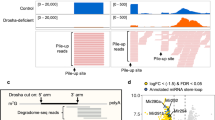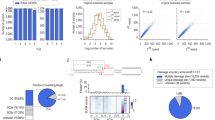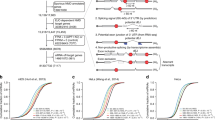Abstract
MicroRNAs (miRNAs) are ∼22-nucleotide endogenous RNAs that often repress the expression of complementary messenger RNAs1. In animals, miRNAs derive from characteristic hairpins in primary transcripts through two sequential RNase III-mediated cleavages; Drosha cleaves near the base of the stem to liberate a ∼60-nucleotide pre-miRNA hairpin, then Dicer cleaves near the loop to generate a miRNA:miRNA* duplex2,3. From that duplex, the mature miRNA is incorporated into the silencing complex. Here we identify an alternative pathway for miRNA biogenesis, in which certain debranched introns mimic the structural features of pre-miRNAs to enter the miRNA-processing pathway without Drosha-mediated cleavage. We call these pre-miRNAs/introns ‘mirtrons’, and have identified 14 mirtrons in Drosophila melanogaster and another four in Caenorhabditis elegans (including the reclassification of mir-62). Some of these have been selectively maintained during evolution with patterns of sequence conservation suggesting important regulatory functions in the animal. The abundance of introns comparable in size to pre-miRNAs appears to have created a context favourable for the emergence of mirtrons in flies and nematodes. This suggests that other lineages with many similarly sized introns probably also have mirtrons, and that the mirtron pathway could have provided an early avenue for the emergence of miRNAs before the advent of Drosha.
This is a preview of subscription content, access via your institution
Access options
Subscribe to this journal
Receive 51 print issues and online access
$199.00 per year
only $3.90 per issue
Buy this article
- Purchase on Springer Link
- Instant access to full article PDF
Prices may be subject to local taxes which are calculated during checkout



Similar content being viewed by others
References
Bartel, D. P. MicroRNAs: genomics, biogenesis, mechanism, and function. Cell 116, 281–297 (2004)
Lee, Y. et al. The nuclear RNase III Drosha initiates microRNA processing. Nature 425, 415–419 (2003)
Tomari, Y. & Zamore, P. D. Perspective: machines for RNAi. Genes Dev. 19, 517–529 (2005)
Ruby, J. G. et al. Biogenesis, expression, and target predictions for an expanded set of microRNA genes in Drosophila. Genome Res. (in the press)
Ruby, J. G. et al. Large-scale sequencing reveals 21U-RNAs and additional microRNAs and endogenous siRNAs in C. elegans. Cell 127, 1193–1207 (2006)
Lim, L. P. et al. The microRNAs of Caenorhabditis elegans. Genes Dev. 17, 991–1008 (2003)
Han, J. et al. Molecular basis for the recognition of primary microRNAs by the Drosha-DGCR8 complex. Cell 125, 887–901 (2006)
Ruskin, B. & Green, M. R. An RNA processing activity that debranches RNA lariats. Science 229, 135–140 (1985)
Padgett, R. A., Konarska, M. M., Grabowski, P. J., Hardy, S. F. & Sharp, P. A. Lariat RNA's as intermediates and products in the splicing of messenger RNA precursors. Science 225, 898–903 (1984)
Hutvagner, G. et al. A cellular function for the RNA-interference enzyme Dicer in the maturation of the let-7 small temporal RNA. Science 293, 834–838 (2001)
Lau, N. C., Lim, L. P., Weinstein, E. G. & Bartel, D. P. An abundant class of tiny RNAs with probable regulatory roles in Caenorhabditis elegans. Science 294, 858–862 (2001)
Lim, L. P. & Burge, C. B. A computational analysis of sequence features involved in recognition of short introns. Proc. Natl Acad. Sci. USA 98, 11193–11198 (2001)
Lo, P. C., Roy, D. & Mount, S. M. Suppressor U1 snRNAs in Drosophila. Genetics 138, 365–378 (1994)
Kim, Y. K. & Kim, V. N. Processing of intronic microRNAs. EMBO J. 26, 775–783 (2007)
Yandell, M. et al. Large-scale trends in the evolution of gene structures within 11 animal genomes. PLoS Comput. Biol. 2, e15 (2006)
Lee, R. C. & Ambros, V. An extensive class of small RNAs in Caenorhabditis elegans. Science 294, 862–864 (2001)
Griffiths-Jones, S. The microRNA registry. Nucleic Acids Res. 32, D109–D111 (2004)
Leverette, R. D., Andrews, M. T. & Maxwell, E. S. Mouse U14 snRNA is a processed intron of the cognate hsc70 heat shock pre-messenger RNA. Cell 71, 1215–1221 (1992)
Grumbling, G. & Strelets, V. FlyBase: anatomical data, images and queries. Nucleic Acids Res. 34, D484–D488 (2006)
Stein, L., Sternberg, P., Durbin, R., Thierry-Mieg, J. & Spieth, J. WormBase: network access to the genome and biology of Caenorhabditis elegans. Nucleic Acids Res. 29, 82–86 (2001)
Pruitt, K. D., Tatusova, T. & Maglott, D. R. NCBI Reference Sequence (RefSeq): a curated non-redundant sequence database of genomes, transcripts and proteins. Nucleic Acids Res. 33, D501–D504 (2005)
Karolchik, D. et al. The UCSC genome browser database. Nucleic Acids Res. 31, 51–54 (2003)
Adams, M. D. et al. The genome sequence of Drosophila melanogaster. Science 287, 2185–2195 (2000)
Richards, S. et al. Comparative genome sequencing of Drosophila pseudoobscura: chromosomal, gene, and cis-element evolution. Genome Res. 15, 1–18 (2005)
Blanchette, M. et al. Aligning multiple genomic sequences with the threaded blockset aligner. Genome Res. 14, 708–715 (2004)
Hofacker, I. L. et al. Fast folding and comparison of RNA secondary structures. Mh. Chem. 125, 167–188 (1994)
Brennecke, J., Stark, A., Russell, R. B. & Cohen, S. M. Principles of microRNA-target recognition. PLoS Biol. 3, e85 (2005)
Dorner, S. et al. A genomewide screen for components of the RNAi pathway in Drosophila cultured cells. Proc. Natl Acad. Sci. USA 103, 11880–11885 (2006)
Forstemann, K. et al. Normal microRNA maturation and germ-line stem cell maintenance requires Loquacious, a double-stranded RNA-binding domain protein. PLoS Biol. 3, e236 (2005)
Lim, L. P. et al. Microarray analysis shows that some microRNAs downregulate large numbers of target mRNAs. Nature 433, 769–773 (2005)
Acknowledgements
We are grateful to P. Sharp, T. Baker and members of the Bartel laboratory for discussions. We thank W. Johnston for assistance with molecular cloning, E. Lai for contributing small-RNA-derived cDNAs for sequencing, the Drosophila genome sequencing community and the UCSC genome browser staff for unpublished alignments, P. Zamore and R. Green for dsRNA plasmids, S. Cohen for GFP and firefly luciferase Drosophila expression plasmids, and D. Sabitini for pMT-puro. This work was supported by the NIH. C.H.J. is a NSF graduate research fellow. D.P.B. is an investigator of the Howard Hughes Medical Institute. Small RNA sequences were deposited in the Gene Expression Omnibus (www.ncbi.nlm.nih.gov/geo/), accessions GPL5061 and GSE7448.
Author Contributions J.G.R. performed the computational analysis. C.H.J. performed the experimental analysis. All authors contributed to the design of the study and preparation of the manuscript.
Author information
Authors and Affiliations
Corresponding author
Ethics declarations
Competing interests
Small RNA sequences were deposited in the Gene Expression Omnibus (www.ncbi.nlm.nih.gov/geo/), accessions GPL5061 and GSE7448. Reprints and permissions information is available at www.nature.com/reprints. The authors declare no competing financial interests.
Supplementary information
Supplementary Information
This file contains Supplementary Figures S1-S2 with Legends and Supplementary Tables S1-S4. (PDF 3538 kb)
Rights and permissions
About this article
Cite this article
Ruby, J., Jan, C. & Bartel, D. Intronic microRNA precursors that bypass Drosha processing. Nature 448, 83–86 (2007). https://doi.org/10.1038/nature05983
Received:
Accepted:
Published:
Issue Date:
DOI: https://doi.org/10.1038/nature05983
This article is cited by
-
Evaluation of expression levels of microRNA processing elements in patients with sudden sensorineural hearing loss
Egyptian Journal of Medical Human Genetics (2024)
-
From diagnosis to resistance: a symphony of miRNAs in pheochromocytoma progression and treatment response
Naunyn-Schmiedeberg's Archives of Pharmacology (2024)
-
Clustering pattern and evolution characteristic of microRNAs in grass carp (Ctenopharyngodon idella)
BMC Genomics (2023)
-
Mitochondrially mediated RNA interference, a retrograde signaling system affecting nuclear gene expression
Heredity (2023)
-
microRNAs in action: biogenesis, function and regulation
Nature Reviews Genetics (2023)
Comments
By submitting a comment you agree to abide by our Terms and Community Guidelines. If you find something abusive or that does not comply with our terms or guidelines please flag it as inappropriate.



